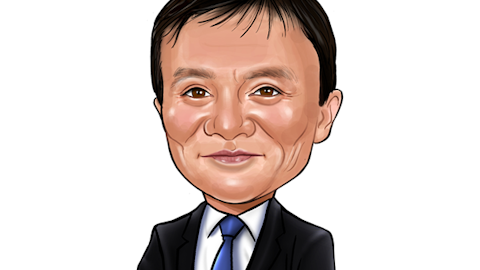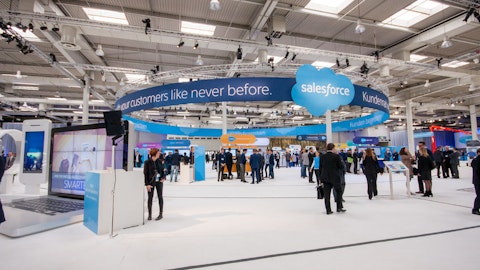Weibo Corporation (NASDAQ:WB) Q3 2022 Earnings Call Transcript November 17, 2022
Weibo Corporation misses on earnings expectations. Reported EPS is $0.5 EPS, expectations were $0.51.
Operator: Good day, and thank you for standing by. Welcome to Weibo Reports Third Quarter 2022 Financial Results Conference Call. Please be advised that today’s conference is being recorded. I would now like to hand the conference over to the company. Thank you. Please go ahead.
Sandra Zhang: Thank you, operator. Welcome to Weibo’s Third Quarter 2022 Earnings Conference Call. Joining us today are our Chief Executive Officer, Gaofei Wang; and our Chief Financial Officer, Fei Cao. The conference call is also being broadcasted on the Internet and is available through Weibo’s IR website. Before the management remarks, I would like to read you the safe harbor statement in connection with today’s conference call. During today’s conference call, we may make forward-looking statements, statements that are not historical facts, including statements of our beliefs and expectations. Forward-looking statements involve inherent risks and uncertainties. A number of important factors could cause actual results to differ materially from those contained in any forward-looking statements.

Photo by Marvin Meyer on Unsplash
Weibo assumes no obligation to update the forward-looking statements in this conference call and elsewhere. Further information regarding this and other risks is included in Weibo’s Annual Report on Form 20-F and other filings with the SEC. All the information provided in this press release is occurring as of the date hereof. Weibo assumes no obligation to update such information, except as required under applicable law. Additionally, I would like to remind you that our discussion today includes certain non-GAAP measures, which excludes stock-based compensation and certain other expenses. We use non-GAAP financial measures to gain a better understanding of Weibo’s comparative operating performance and the future prospects. Our non-GAAP financials exclude certain expenses, gains or losses and other items that are not expected to result in future cash payments and are nonrecurring in nature, are not indicative of our core operating results and outlook.
Please refer to our press release for more information about our non-GAAP measures. Following management’s prepared remarks, we will open up the lines for a brief Q&A session. With this, I would like to turn the call over to our CEO, Gaofei Wang.
Gaofei Wang: Thank you. Hello, everyone, and welcome to Weibo’s Third Quarter 2022 Earnings Conference Call. On today’s call, I will share with you highlights of Weibo’s user, product and monetization in the third quarter of 2022. On the user front, Weibo’s MAUs reached 584 million, and average DAUs reached 253 million in September 2022, adding approximately 11 million and 5 million users year-over-year, respectively. In September, 95% of Weibo’s MAUs came from mobile. Monetization with macro-economy and consumption weighing on the overall advertising market, our clients remain cautious towards their advertising budget spend. In the third quarter, our total revenues reached $453.6 million, a decrease of 25% year-over-year and an increase of 1% quarter-over-quarter.
Excluding the foreign exchange impact, our total revenues decreased 20% year-over-year and increased 5% quarter-over-quarter as revenues reached $393.4 million this quarter and 95% of our ad revenues came from mobile. This year, we have focused on improving our operating efficiency. In the third quarter, our non-GAAP operating income reached $162.1 million, representing a non-GAAP operating margin of 36%, up from 32% last quarter. Next let me share with you our progress made in product and monetization in the third quarter. Our target on product operations still focused on strengthening the platform’s competitiveness through improving operating efficiency, maintaining large user scale and enhancing user engagement. In this quarter, with the summer holiday season and hot trends effect, our overall traffic reached its peak level in August this year.
Based on our experience, the opening of the fall semester in September usually negatively impact our traffic, especially when Campus promotion suspended this year due to COVID-19 related control measures. In response, on the product and operational front, we have stepped up our efforts in the areas of channel investments, community product optimization and cultivation of entertainment and eSports verticals, which resulted in healthy trend of our overall traffic in September. On the channel front, the ROI of our channel investment for the third quarter was further improved. We continue to strengthen our cooperation with handset manufacturers in Weibo top trends and social products while focusing on investing in high ROI channels. This quarter we achieved full coverage for Weibo’s hot trend content in the core positions on handset devices of domestic leading manufacturers.
Meanwhile we further upgraded our service for domestic smartphone users and enhanced their consumption through improving the quality of hot trends content considering the handset attributes and users’ consumption scenarios. In September, the number of our hot trends users from domestic handsets increased 30% quarter-over-quarter. Next we will continue to deepen our cooperation with handset manufacturers to focus on long-term mutual benefits, expand cooperation to more app use Weibo’s core products and content and increase Weibo’s user scale through handset tech channels. On social attributes, this quarter, we continue to enhance social features of our products and increase the scale and engagement of our core users on relationship-based feed while maintaining user traffic.
User interaction continued to grow in September, representing improved user stickiness. In July and August, which is the peak season of traffic due to the summer holiday, Weibo’s content generation largely increased, particularly for verticals such as celebrities, TV series, variety shows and games et cetera. We lean our traffic distribution towards these verticals with strong stickiness of young users in the relationship-based feeds, which helped enrich the vertical content ecosystem and enhancing user interaction and consumption in relationship-based feed. In the meantime, we continue to improve the distribution structure of our relationship-based feed, further increase the distribution of content generated by KOLs and community-based content to emphasize the social features of our relationship-based feed.
In particular, we made significant upgrades in algorithms to enhance distribution of community content, further integrating the community-based content and user-generated content. As a result, in the relationship-based feed 70% of users were able to consume quality community-based content of their interest directly in the feed. In September, traffic generated from community-based content distributors in the relationship-based feed and the number of users who made interactions through community contents have increased more than 50% quarter-over-quarter, which further facilitates users’ relationship building and interaction efficiency in a relationship-based feed. In the third quarter, we continued to beef up our investments in community products to strengthen the perception of community products by all users.
On one hand, with the independent tab of super topic at the bottom of main page launched in June, we are able to improve new users’ willingness to revisit the tab through prioritizing traffic distribution for quality community content, coupled with our effective user recall strategy. In September, the DAU’s Super Topic tab increased by more than 50% compared to that of June, half of which were new users for community products. Now only has the scale of users growing, users consumption stickiness increased significantly with capital consumption of community-related contents increased by 40% from June. On the other hand, we further enhanced functions and mechanism of the community products, such as new functions of posting and interaction that launched in the third quarter.
The increased user stickiness in the community significantly drove the production and the interaction of quality contents in entertainment and online gaming verticals. In September, the number of users who posted and interacted in the community continued to grow double digits compared to June, while the number of post and interactions increased twice the increase of users. We believe that the constant building of our community products has strengthened the social stickiness of Weibo users, boding well for the long-term healthy development of the platform. On the content front, our strategy this year is to focus on developing social accounts in key verticals to constantly solidify our advantages in key content verticals as well as high quality accounts.
And thus drive the improvement of operating efficiency. In terms of the online gaming vertical, which further cultivates our ecosystem around eSports events and deepen cooperation between Weibo and top eSports clubs. In third quarter, the daily number of posts by eSport players has increased by 50% quarter-over-quarter with both traffic and interactions doubled. Coupled with tournaments-related hot trends, the overall traffic from the eSports vertical grew over 50% sequentially. We have also attracted a wider group of young users and generated higher user engagement while helping eSports clubs build up influence and market value on our platform. As for the entertainment industry, the summer holiday was the peak season for TV series and variety of shows.
We focused on partnership with video platforms and show producers to improve distribution of hot trends and user interactions, driving the volume of blockbusters to grow across the platform. In third quarter, the traffic and the interaction of TV and variety shows continued to trend up compared to that of the last summer holiday. In particular, the traffic for TV shows has reached record high, which more than doubled compared to the same period last year with multiple phenomenal project streamers. TV shows Love Like the Galaxy and the Love Between Fairy and Devil have generated over 40 billion topic views and 28 million discussions, reinforcing Weibo’s position as a designated platform for show launching and promoting. Going forward, we will continue to actively support our partners and drive healthy development of the entertainment ecosystem.
Moving on to monetization. In the third quarter, we saw a general recovery trend of ad spend on a sequential basis with various pieces across different industries. For example, in auto industry, thanks to positive support for new energy vehicles industry and the enhanced market recognition for Weibo’s integrated new car launching marketing solution for automakers over the past 2 quarters. Weibo’s index product launch and marketing solutions attracted over 90% of the overall new model launches. On top of regular brand exposure, leveraging the combo of media, vertical KOLs and hot trends, Weibo has successfully expanded its market share in new car launches, leading to sustained double-digit year-over-year growth in ad revenue from auto industry in the third quarter.
As for the luxury sector, ad revenues also booked significant year-over-year growth due to the intensive launch of new lines and shows in the third quarter. In terms of online gaming industry, our differentiated marketing model that we have established over the past 2 years has resonated greatly among game developers. Even though the new games approval this year has shrunk, we have effectively helped these game developers improve user ARPU and lifecycle, leveraging cooperation around contents with our top-tier game clients and event-based marketing products and services. As a result, Weibo has gained certain ad budgets and further solidified our market position among advertisers in the online gaming sector. Other industries such as the FMCG industry continued to be impacted by headwinds of COVID-19 control measures and weak consumption season, with brands taking a wait-and-see attitude in their branding budget allocation.
E-commerce platforms and the 3C products also experienced varying degrees of decline in the third quarter due to market conditions and the industry slow season. Talking about outlook, overall advertising business for the fourth quarter and the first half of next year. There is still relatively high uncertainty under the market circumstance. However, we are pleased to see positive signals with certain industries. For example, e-commerce platforms and FMCG clients have released adverts during the Double 11 shopping festival to various degrees. Although the Double 11 shopping festival was shorter this year as budgets from e-commerce platforms returned to a growth trajectory compared with the same period last year. In third quarter, we focused on conforming our algorithm to accurately fulfill the marketing needs of e-commerce platforms on the ad product front and expect to gradually capture certain advertising budgets in the fourth quarter.
Meanwhile, the fourth quarter is also a key season for new product launches in the handset sector with all major handset manufacturers launching key models in their pipeline. As such, we are actively working with our clients to develop constant marketing plans to further deep up Weibo’s market share in new phone launches. Moreover, the 2022 World Cup in the fourth quarter will be a key advertising window for many of our clients, especially in the food and beverage sectors. We are cooperating with clients and discussing their open marketing fencing details to tap into World Cup-related hot trend in the hope of enhancing app performance and our wallets. Not least, let me briefly recap on Weibo’s progress in our initiatives to optimize costs and improve operating efficiency.
As mentioned in our last earnings call, we have taken a series of effective measures to optimize our cost and expense structure and enhance efficiency during the year to better control our ROI on cost end. These measures continue to bear fruit, leveraging our solid execution. In the third quarter, we delivered a non-GAAP operating margin of 36%, up nearly 4 percentage points versus 32% in the second quarter, benefiting from solid execution of disciplined spending strategy to further improve operating efficiency. This has demonstrated our improvements in operating efficiency, giving us the opportunity to win our resources towards more potential areas. Taking channel investment as an example, through strategic channel cooperation, we acquired more high-op users and SaaS shortened the ROI retrieving period of China investments.
Currently, the cost retrieving cycles of most of our channels shortened to nearly half of that in the same period last year. On the product operations front, we deepened the strategic cooperation with our content partners focused on social products and strengthen our advantages in hot trends and key verticals such as eSports and sports. We built strategic partnership with video site, mainstream media and eSports club this year to acquire more content and users. Despite potential costs incurred in the short run, we could significantly enhance our competitiveness in content operations and improved the operating efficiency of the platform’s traffic. On the ad product front, for one thing, we will tap into market trends and beef up our investments in content marketing to strengthen our differentiation.
For another, we focus on delivering breakthroughs in accurate algorithm adaption to capture e-commerce ad budget. Looking into the fourth quarter, we will continue to execute against our strategy of reducing costs and improving efficiency with more focus on adjusting our cost structure and optimizing resource allocation to ensure efficient operation of our company on the high uncertainty of macro environment and solidify our long-term competitiveness. With that, let me turn the call over to Fei Cao for a financial review.
See also 12 Best Ethical Stocks To Buy and 12 Best Bear Market Stocks To Buy Now.
Fei Cao: Thank you, Gaofei, and hello, everyone. Welcome to Weibo’s Third Quarter 2022 Earnings Conference Call. Let’s start with user metrics. In September 2022, Weibo’s MAUs and average DAUs reached 584 million and 253 million, respectively, representing a net addition of 11 million and a 5 million users, respectively, on a year-over-year basis. We are pleased to see healthy engagement trends and video consumption despite the back-to-school seasonality and ongoing disciplined channel marketing strategy, demonstrating Weibo’s scored by the proposition to users. Turning to financials. As a reminder, my prepared remarks would focus on non-GAAP results or monetary amounts are in U.S. dollar terms and all the comparisons are on a year-over-year basis, unless otherwise noted.
Now let me walk you through our financial highlights for the third quarter of 2022. Weibo’s third quarter 2022 net revenue was $453.6 million, a decrease of 25% or 30% on a constant currency basis. Operating income was $15.1 million, representing an operating margin of 36%. Net income attributable to Weibo reached around $519 million, representing a net margin of 36%. Diluted EPS was $0.50% compared to $0.90 last year. Now let me give you more color on revenues. Weibo’s advertising and marketing revenues for the third quarter 2022 reached $383.4 million, a decrease of 27% or 21% on a constant currency basis, reflecting a caveat of marketing advertising market as we expected. Mobile ad revenues were $372 million, contributing approximately 95% of total ad revenues.
With COVID resurgence and mainly on the overall demand side, our advertising business continued on descending trajectory year-over-year, while booking a moderate sequential growth during the quarter. Our leading verticals in terms of ad revenue contributions in the third quarter for FMCG 3C products and online games. In terms of growth, the luxury and automobile sector exhibited a solid recovery trend, booking double-digit growth both on annual and sequential basis. Benefiting from tailwinds are the electronic vehicle industry, policy similar to the automobile industry and an eventful product launch season for luxury brands. We beefed up sales efforts to capture high value share in this sector with our full spectrum of social ad solutions.
The online game sector also demonstrated relative resilience as our brand close performance ad offerings resonated greatly with team developers. On the flip side, discretionary consumption categories and the e-commerce sector remained sluggish and mid-week consumption sentiment, lukewarm sales data and broad-based initiatives to optimize costs and expenses among our customers. From the ad product perspective, promoting fees continued to be the largest part, followed by social display ad and search and topic ad offerings in less of industry-wide pricing pressure and add execution challenges. We proactively took the window to optimize our ad technology and product in the hope of capturing more performance-driven ad , which is more defensive in the current market condition.
Meanwhile, we are steadfastly focused on highlighting our market differentiation as well as further timing into the visualization change of the ad market. Entering the first quarter, we are seeing sense of advertising market bottoming out in a more moderate and gradual pace. Thus that, leveraging the upcoming e-commerce festival, we will beef up our product and sales execution to capture the potential pent-up market opportunities, while mandate to many headwinds in the near term. We remain confident in our long-term monetization opportunities that our unique value proposition and a diversified content ecosystem will unlock. Ad revenues from Alibaba for the third quarter was $15 million, a decrease of 28% or 22% on a constant currency basis, which is generally in line with our overall advertising business performance.
Value-added service, VAS revenues were $16.1 million in the third quarter, a decrease of 14% or 8% on a constant currency basis. The decrease of VAS revenues was mainly due to less revenue contribution from membership services. Turning to cost and expenses. Total cost and expenses for the third quarter were $291.5 million, a decrease of 19% as we implemented our efficiency initiatives to stabilize earnings. The decrease was across each cost and expense items, such to ongoing stringent cost control measures on various operational fronts, especially disciplined channel investments and reduced off-line activities. Operating income in the third quarter was $102.1 million, representing operating margin of 36%, improved from 32% in the second quarter.
Our market performance has exceeded our expectations as our cost optimization initiatives continue to bear fruit despite COVID headwinds and the macro challenges. Turning to income tax. Under GAAP measure, income tax expense for the third quarter was $19.8 million compared to $31.4 million last year. Net income attributable to Weibo in the third quarter was $19 million, representing a net margin of 36% compared to 34% last year. Turning to our balance sheet and the cash flow items. As of September 30, 2022, Weibo’s cash, cash equivalents and short-term investments totaled $3 billion compared to $3.1 billion as of December 31, 2021. In the third quarter of 2022, cash provided by operating activities was $74 million. Capital expenditures totaled $4.6 million and depreciation and amortization expenses amounted to $13.2 million.
Before turning to the Q&A session, I would like to provide an update on share repurchase program. Ended up to first $500 million share repurchase program authorized in March this year, we have repurchased a total of approximately 3.1 million ADS for a total cost of $157.7 million as of September 30, 2022, as means to return value to shareholders amid the turmoil market. With that, let me now turn the call over to the operator for Q&A session. Thank you.
Q&A Session
Follow Wachovia Corp New (NASDAQ:WB)
Follow Wachovia Corp New (NASDAQ:WB)
Operator: First question comes from the line of Alicia Yap from Citi.
Alicia Yap: I have a question related to the advertising outlook and sentiment in the fourth quarter as well as into the 2023, given the strict of COVID policy and also the weakness in the macro. How should we think about the growth rate as comparison to the third quarter in terms of the declining magnitude, will the 4-Q year-over-year decline be bigger steeper than what we saw for the third quarter? And then as we go into 2023, can management also kind of split in terms of preliminary review for the first half versus the second half growth? How should we think about whether the first half should be more conservative and then second, how we should see some resumption of the growth?
Gaofei Wang: All right. Thank you for the question. So with regards to the Q4 and also the 2023 performance. So you can see, first of all, I’d like to talk to you about the structure of our basement. So 2/3 of the industries are actually related to consumption, for example, FMCG or 3C products as well as the e-commerce. So you can see that the recoveries is highly related to the macro. So next of all, I would like to talk to you about the focus. So you can see that we’re going to narrow in the kind of a trend in Q4 and also going to realize a quarter-over-quarter improvement. in the future. And also now I would like to talk to you about the situation. So as you can see that talking about some of the offline scenarios and also more offline activities.
So in October, we had a lot of activities and most events organized for national institutions so that we’ve got some suspension of the offline activities organized by our customers. So we had a big impact in October. However, you can see that talking about the e-commerce, they had actually great improvements because of the Double 11 shopping festival and also the Double 12 shopping festival as well, so that especially talking about the FMCGs. So they’re going to educate more budget actually in these 2 events time frames. And also, the overall trend will be upward. Also, last year, we had a very special category, which is the live stream e-commerce. And due to certain reasons, they had actually a big decline in terms of this particularly this year’s performance.
And also the next one is that talking about the Q4. On the overall basis, the overall category of e-commerce will be experiencing a very stable trend. And also talking about the World Cup, we can see that on budget is going to be allocated with us in the World Cup. So that’s especially FMCG. So that is to say that we’re going to receive the same budget of the FMCG allocation of their advertisement in the World Cup session, which is quite equal to the section of the Winter Olympics. So now I would like to share with you some of the colors. Like, for example, if we are talking about the new control COVID-control policy, especially the new 20 items that are issued by the government in controlling the COVID and also some of the similar policies towards the release industry, we are able to see a very good recovery of the consumption side.





